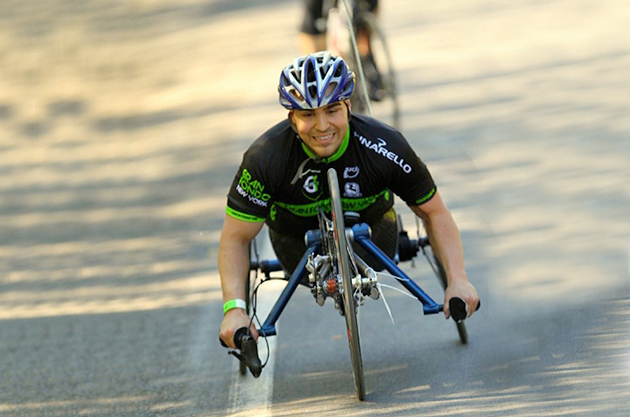This article was first published in the Spring 2014 print edition of UConn Magazine. To read more stories like this, visit s.uconn.edu/spring 14 or download UConn Magazine’s free app for tablet devices.

One August morning shortly before he was to start his senior year of high school, John Tartaglio ’14 MBA woke up with what he calls a “really alarming pain deep in my legs.” What he didn’t yet know was that an extremely rare bacterial infection – so uncommon that only 35 other people have ever been diagnosed with it – was raging throughout his body.
Over the next 24 hours, doctors did everything they could to save his life. Tartaglio, 17 years old at the time, returned to consciousness following what he thought would be exploratory surgery to devastating news: He no longer had legs. The infection – the source of which was never determined – had spread so exceptionally fast that both his legs had to be amputated above the thigh.
“A nurse came in and told me,” says Tartaglio, now 26. “I had tears in my eyes, and they were coming down my face, but I was just cold. I didn’t want to deal with it. I didn’t want to respond to it. I didn’t want to acknowledge it.”
15 Hours and 59 Minutes
Tartaglio spent several weeks recuperating in the hospital before moving on to physical therapy sessions at an outpatient facility. Because of the level of amputation, he was told by doctors and prosthetists alike that he would probably never walk again. “That wasn’t really the answer I wanted to hear,” he says.
By Christmas, however, he had found a prosthetist who could help. That April, at a 2-mile walk held in his honor, he walked a quarter of a mile for the first time since the amputation – a moment that he says changed his perspective for good “about what I was able to do, what capability I had.” He had reached another milestone by June, walking at his high school graduation ceremony to accept his diploma.
That summer, one of his physical therapists suggested Tartaglio take part in a team triathlon. Then his prosthetist offered him the opportunity to try out a prosthetic that would allow him to run.
“I didn’t ever think I’d have the opportunity to run,” says Tartaglio, who laughingly admits he had despised running before his amputation. “That was a big mindset change.”
Tartaglio went on not only to complete in a triathlon, but also numerous other endurance races – from a 100-mile cycling race to a half-Ironman.
“It starts out as one thing,” he says. “Then I was thinking: How can I step it up? How can I challenge myself even more? These weren’t ever things that I saw myself doing. So to be able to challenge myself and to be able to succeed, I was just pushing my own boundaries to see what I could do.”
In 2009, a mere five years after being told he would never walk again, Tartaglio became the first person with no legs to complete the New York City Marathon – crossing the finish line after a grueling 15 hours and 59 minutes. His record still stands.
“I made it pretty clear to people that if I wanted to do it, it would happen,” he says.
‘How far you fall’
Tartaglio has not stopped making things happen. Today, he travels the country to inspire audiences with his story and has even appeared on “The Oprah Winfrey Show.” A UConn student, he is finishing his MBA at the School of Business this spring and interning in business development at Philips in Stamford, Conn. He and his wife have a daughter, Lily, who turns 1 this month.
He also recently authored a memoir, From Tragedy to Triumph: The Story of John Tartaglio (No Limits Publishing, 2013), now available on Amazon. And this past fall, he spoke at UConn’s first student-organized TEDxUConn (available for viewing on YouTube), a conference series that features lectures on technological, sociocultural, and global trends.
One of the main messages he shares with his audiences centers on his own personal mantra: “How far you fall doesn’t determine who you are; it’s how hard you work to get back up.”
“Regardless of who you are, you’re going to have adversity,” he says. “You’re going to face some type of obstacle. How do you quantify that? You don’t. You can’t compare my adversity to your adversity. It’s different. I don’t care who you are, what your demographic is, what your background is, you have it. But it’s not about that. It’s not about what your adversity is compared to other people. It is what you do to face it, what you do to overcome it. That really defines who you are.”
With his UConn MBA complete, Tartaglio says he will look to get back into road races while continuing with his speaking engagements. At the same time, he has his sights set on pursuing a career in the business world as an internal consultant, using the same talent he has worked so hard to cultivate these past 10 years: motivating people to reach new goals.
“For me, it has to do with being able to influence people and leading them to improve their performance,” he says. “I want to be able to help people get there. I like the idea of being able to help drive a strategy and have that bigger positive impact. That’s really the tie-in. Having the personal connection is what would make it something I’d be happy doing for a career.”
Learn more about John Tartaglio at johntartaglio.com, or watch his TEDxUConn talk at s.uconn.edu/tartaglio.



